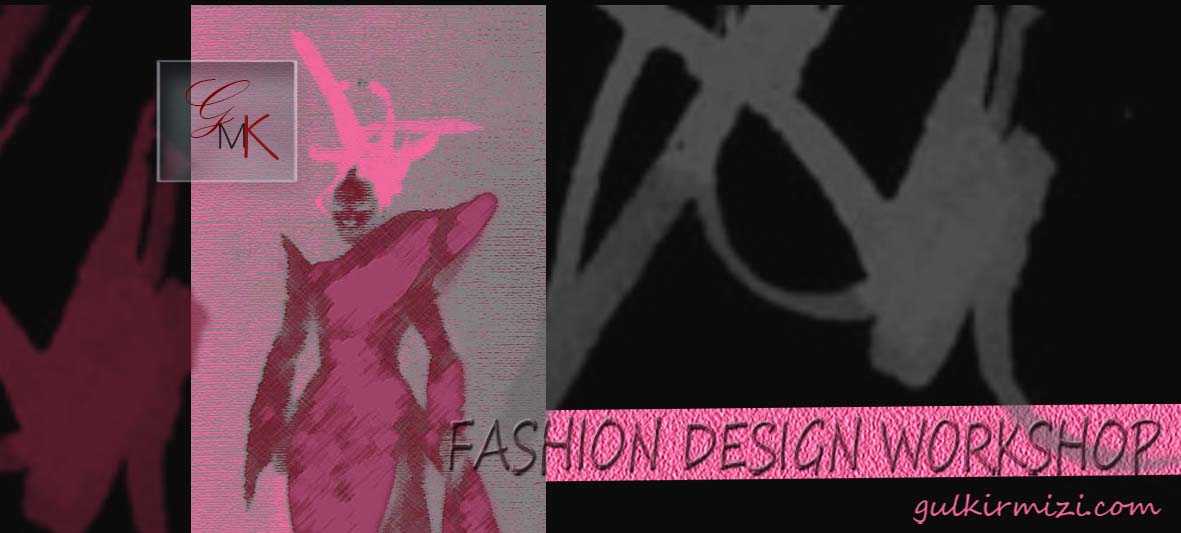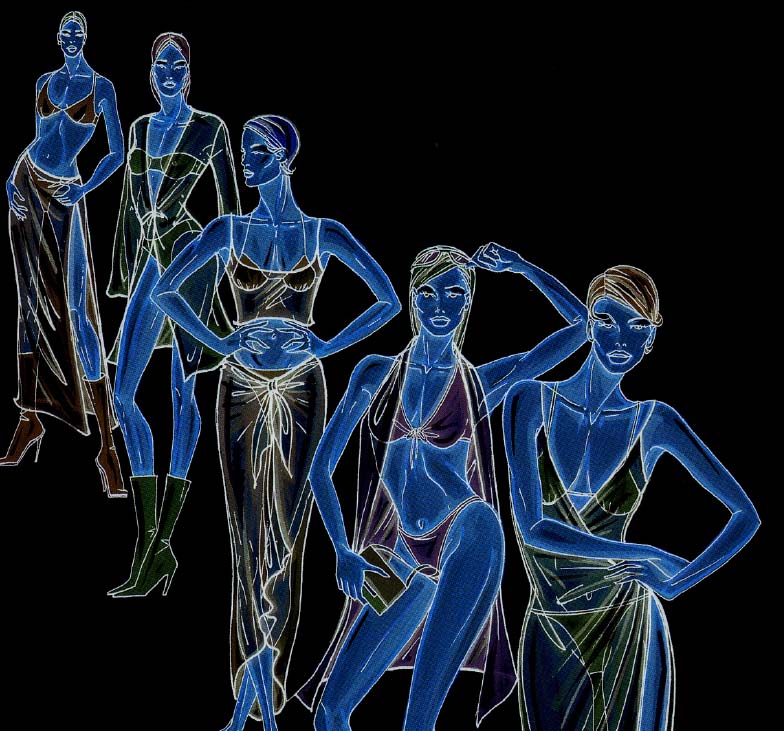
Fashion Design Workshop
Academic Program – Course Description
Instructor:
Gul Menet Kirmizi – Hatko Marshan (MFA – DEU)

|
Total 30 Hours |
Level
|
3. Year & Upper Levels |
|
Prerequisits
|
Computer Aided Design – 1 & 2 (2D – 3D) |
|
|
Hours |
Total hours per week
|
|
|
Lessons (at Studio) |
3 Hours (Lecture)per week
|
3 |
|
Interactive discussions at the office (optional) |
4 Office Hours per week
|
4 |
|
Labs / Studio & Practice |
24 Hours (Studio Work) Total Workshop
|
|
|
Final presentations |
Semester Project
|
|
|
DETYRIME |
Semester
|
|
Assignments / Presentations |
Students will do weekly Powerpoint presentations based on Active Learning Methods
|
|
Projects |
Students will submit weekly homeworks (pojects) and/or reports at the end of each week.
|
|
Discussions |
Optional discussions will be done during office hours
|
|
Exams |
Flat Technical Board & Inspirational Board & Portfolio Presentations (Digital Design)
|
|
Credits |
3 Credits
|
1. General Course Description
The study of fashion and the way in which materials and methods affect the design potential as well as the skills of fashion making. Social attitudes and previous fashion trends affecting the development of fashion design.
The qualities and skills necessary to become a fashion designer. Color and pattern making. Basic knowledge about the fashion business. Performing research, knowledge of fabric, coordinating color and texture and monitoring quality and fit. Students are expected to be able to: apply basic fashion design knowledge in fashion design activities, such as:
● Developing simple fashion design drawings with the application of techniques by using drawing tools and CADD - CAMM tools
● Presenting fashion design ideas in a logical manner with the proper application of visual, verbal, graphical and/or written communication skills;
● Demonstrating the basic mastery of pattern construction;
∑ Course Outline
● Historical Content. Brief historical development of fashion. Introduction to art & design history and its relation to a broader socioeconomic context.
Historical costume in ancient Egypt, Greece, Rome, Byzantium and west Europe from the 5th to the 10thcentury D.C.
How the gothic style and the medieval garment entered the contemporary fashion atelier.
● Research and study of garments, colors, lines, fabrics during medieval times (from the 11th to 15th century) with simultaneous mention of the gothic style in architecture, painting and literature
The Renaissance silhouette aesthetics. Clothes during the 16th and 17th century in Europe. Modern references and inspirations. Art and design history until the 20th Century and its relation to socioeconomic issues
Historical, cultural, heritage and environmental influences on fashion design. Connection between the historical costume and contemporary creations
● The basic terminology of Fashion Lesson The philosophy of design and the methods and means used to develop elements from various sources. Garment designs accompanying specific themes. Design creations provoked by the senses. Emotions inspired by music, painting, dancing, etc
● The basic creative and manipulative skills necessary for fashion design and fashion making. Analysis and study of the relation between clothes accessories in correlation with the body of every woman
● Introduction to the principles and values of Aesthetics. Aesthetic analysis of commercials and famous designer's campaigns. Fashion trends study and research as to which will be the next season's trends
● Theoretical introduction to the fashion system. Study of the great designer's contribution to fashion (especially during the '80's and '90's). Present and past-Famous designers: What is Haute Couture and which are the key elements by which it is recognized. Separation from the prÍt a porter.
● Color . Principle of colour matching for fashion design. The use of color and texture in fashion drawings
● Fabric. Cotton, linen, wool, silk, synthetic materials and lace, etc…. Introduction fabric, analysis of their characteristics. Introduction to technical knowledge necessary for the creation of a garment. The module also introduces students to the design and cutting of the basic structures of dresses.
● Developing personal creativity and style. The power of visual messages. Analysis of Fashion images and how they are created through combination of various elements.
● Defining a Project. Creation of complete units comprising impressive original collections.
● How to construct a garment. Further acquisition of technical knowledge and skills related to the creation of patterns and garments. Students will become aware of and practice design. Sewing techniques and studio practice.
● Basic principles of human body design with basic rudiments of human anatomy. Studying female body. Reproduction of female body through the special sizes that affect the international fashion. Study and analysis of the way in which professional fashion designers design the most representative body poses. Study of facial features. Colored pencils techniques and chiaroscuro techniques. Mixing colors and making tints.
● Fashion Business. Haute Couture. Theoretical introduction to issues of Haute couture in regards to pattern applications and distinct construction methods
● Portfolio,logo, tag and poster presentations (CADD-CAMM workshops for design, rendering and presentation purposes.)
● Processing Orders
2. Course Objectives
1. History of Fashion Design
● A Timeline of Costume Design
● Principles of Fashion Design
● Coloring, design, different rendering methods
● Fashion Designer collections
● Manual & digital technical Fashion Drawing
● Preparing Fashion Collections
3. Program Material
Students will be exposed Manuals of related Programs and Selected web sites.
4. Assignments
Students will submit weekly homeworks and/or reports at the end date of each week.
5. Methodology
Instruction Methods and Techniques Used
|
■ |
Lectures |
■ |
Seminars |
|
■ |
Multi-media and interactive presentations |
■ |
Group work |
|
□ |
Field and Experimental Course work |
■ |
Students participations |
|
■ |
Computer Applications and Programming |
■ |
Presentations by students |
|
□ |
Site visits, projects, construction sites and professional offices |
□ |
Preparation of Research work, brief / extended |
Knowledge and Skills to be acquired
|
■ |
Knowledge and understanding of subject |
■ |
Team work abilities |
|
■ |
Ability to apply acquired knowledge on similar cases |
■ |
Positive participation and self expression |
|
■ |
Thinking, Critical / Creative |
□ |
Preparation of Field Reports |
|
■ |
Ability to Analyze and study |
■ |
Ability to locate resources and information |
|
■ |
Professional work : Professional Practice and Ethics |
■ |
Research abilities; Preparation and presentation |
6. Examinations and Evaluation of Work
|
Evaluation and Grading
|
Percentage of Final Grade |
|
|
1 |
Participation in Class |
10 |
|
3 |
Attendance |
10 |
|
4 |
Weekly Examinations |
10 |
|
5 |
Final Presentation |
20 |
|
6 |
Final Portfolio / Project |
50 |
|
7 |
Total Score |
100 |
7.
Workshop Literature

(Please use "Mouse Right Click" and "Save As" option to download )
Homeworks:
Homework 4 Fashion Moodboard
Tutorials:
Tutorial 3 "Designer Collection"
Tutorial 4 "Fashion Design Principles"
Tutorial 6 "Presentation Board"
Tutorial 8 "Collection Samples"
E-Books: (E-Books can be obtained from Polis University Library).
Elements and Principles of Fashion Design